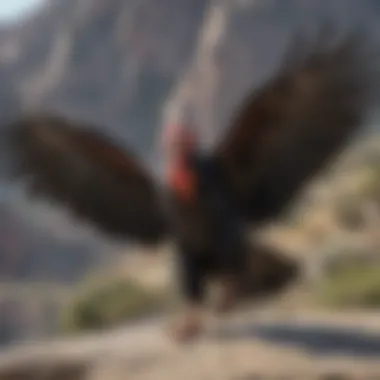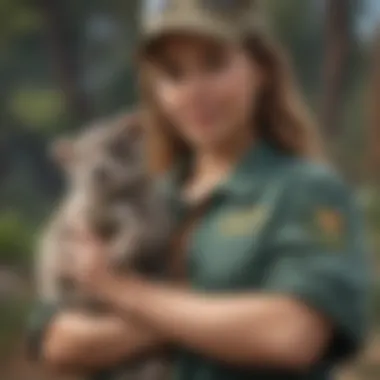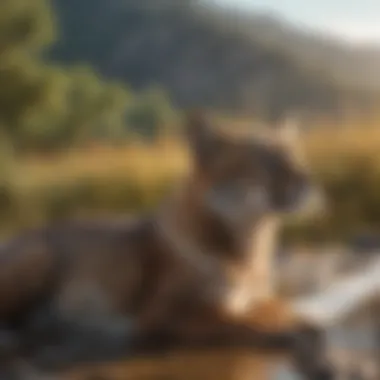Wildlife Rescue Efforts in Southern California


Intro
In the diverse tapestry of Southern California, wildlife plays a crucial role in maintaining ecological balance. Yet, countless challenges threaten the survival of various species, from urban encroachment to habitat degradation. This article aims to take you through the intricate workings of wildlife rescue operations in this vibrant region, showcasing the dedicated organizations, the pivotal support from the community, and the legal complexities that govern these initiatives. By spotlighting the urgent need for conservation, the hope is to inspire individuals and families to partake in these essential efforts in a responsible and impactful manner.
The Stakes: Wildlife Challenges in Southern California
Southern California is home to a rich array of fauna, from the majestic California condor to the elusive desert tortoise. Unfortunately, these inhabitants are navigating a perilous landscape.
- Urban Development: As cities expand, natural habitats are eroded, forcing many species to adapt or perish.
- Pollution: Contaminated waters and air can disrupt the delicate balance of ecosystems, making it harder for wildlife to thrive.
- Climate Change: Altered weather patterns can shift migration routes, breeding cycles, and feeding opportunities, leading to further strain on species populations.
This intricate web of challenges highlights the importance of dedicated wildlife rescue efforts.
Key Organizations in Wildlife Rescue
Several organizations are actively involved in rescuing and rehabilitating wildlife throughout Southern California. Their efforts and expertise are invaluable for ensuring the survival of many species.
- California Wildlife Center: Focused on the rehabilitation of native wildlife, they provide a vital refuge for injured and orphaned animals.
- Pacific Wildlife Care: Offering a 24-hour wildlife rescue hotline, they emphasize the need for immediate responses to wildlife emergencies.
- Irvine Wildlife Association: This organization not only rescues but also educates the community about coexisting with local wildlife.
These organizations rely heavily on volunteers and community support, showing how pivotal collective effort can be in wildlife conservation.
The Community Connection
Wildlife rescue isn’t solely the domain of organizations; everyday community members hold an essential role. Local residents can aid in various manner:
- Reporting Injured Wildlife: If you spot an injured animal, contacting a wildlife rescue organization is crucial.
- Adopting a Rescue Animal: Many organizations handle domestic animals that suffer from abandonment or abuse, providing much-needed love and care.
- Participating in Educational Programs: Community outreach programs can teach essential wildlife safety and awareness.
These small actions contribute significantly to larger rescue operations and wildlife health.
Legal Framework Surrounding Wildlife Rescue
Navigating the legal landscape of wildlife rescue can be daunting. Various laws and regulations aim to protect endangered species and ensure humane treatment. Some essential points to keep in mind include:
- The Endangered Species Act: This landmark legislation provides a framework for the protection of threatened and endangered species.
- State Guidelines: California has specific regulations addressing the rescue and rehabilitation of wildlife, ensuring that operations align with conservation goals.
- Permitting Requirements: Many organizations require permits to handle and care for certain species, ensuring that trained professionals are managing care appropriately.
Understanding these legalities not only aids organizations but also empowers individuals to support wildlife rescue initiatives lawfully and responsibly.
Epilogue
Foreword to Wildlife Rescue
Wildlife rescue plays a crucial role in maintaining the balance of nature and addressing the pressing issues that wildlife face in today’s world. In Southern California, this endeavor is particularly significant due to the region's rich biodiversity and various ecological challenges. Recognizing the importance of wildlife rescue isn't just about saving individual animals; it extends to preserving entire ecosystems. Each rescued animal has an impact on the food chain, and their rehabilitation and return to the wild contributes to a healthier environment.
Understanding Wildlife Rehabilitation
Wildlife rehabilitation refers to the process of providing care for injured, orphaned, or sick animals with the aim to return them to their natural habitats. In Southern California, where wildlife and urban areas frequently intersect, the need for rehabilitation is increasing. Every day, wild animals encounter dangers such as habitat destruction, vehicle collisions, or interactions with domestic pets.
The rehabilitation process is not merely about medical treatment. It requires a deep understanding of the species' natural behavior and habitat needs. A short spell in the clinic can be enough to heal a physically injured animal, but for behavioral recovery, there may be essential training involved. In fact, some animals may not be able to reintegrate due to prolonged human contact or improper handling.
Successfully rehabilitated animals can play an essential role in the ecosystem by controlling pest populations or maintaining diverse plant life, which contributes to a thriving environment. Involvement in wildlife rehabilitation also provides community members with opportunities to engage with nature and learn more about local ecosystems.
The Role of Wildlife Rescues in Ecosystem Health
Wildlife rescue organizations serve as the frontline defenders not just for individual animals, but for the ecosystem as a whole. These establishments dedicate their resources to understanding wildlife needs, enhancing public awareness, and advocating for healthier habitats. The connection between wildlife health and ecosystem vitality is intricate; a drop in one can precipitate issues in the other.
For instance, healthy populations of native wildlife such as raptors help keep rodent populations in check, while the disappearance of these predators can lead to rodent overpopulation and subsequent damage to crops and landscapes. An effective wildlife rescue organization in Southern California isn’t just responding to emergencies; it’s also actively working to address the causes of wildlife distress by promoting sustainable practices and conservation efforts.
"Wildlife rescue is not just about saving individual lives; it's about saving the fabric of our ecosystem by nurturing the species that play essential roles within it."
Southern California: A Unique Habitat
Southern California boasts a unique ecological tapestry that is both enchanting and fragile. The diverse climate zones, ranging from coastal regions to arid deserts and rugged mountains, create a haven for wildlife. This area's rich biodiversity means that it hosts not only a variety of animal species but also an array of plant life, shaping the habitat that supports them. Protecting wildlife in this region is paramount, as these species contribute significantly to the ecological balance.


Diverse Species in the Region
The Southern California habitat is home to a multitude of species that are uniquely adapted to thrive in its varied environments. Here are some noteworthy examples:
- Bald Eagle: Once on the brink of extinction, the Bald Eagle has made a remarkable recovery, particularly near the shores of several local lakes and national parks.
- Desert Tortoise: This remarkable reptile, a symbol of desert resilience, showcases the delicate ecosystem of the Mojave Desert, as it plays a vital role in the health of the area.
- California Condor: One of the rarest birds on the planet, the California Condor was brought back from the edge of extinction through collaborative conservation efforts, highlighting the critical role of active wildlife rescue programs.
In addition to these notable species, the region supports countless smaller creatures, including amphibians, reptiles, and insects, all of which are interlinked within a complex food web. Each species is not just an individual; it plays a role in maintaining the overall health of the ecosystem. Understanding this interconnectedness is essential when considering conservation efforts.
Environmental Challenges Facing Wildlife
As beautiful as Southern California is, it faces a barrage of environmental challenges that threaten its wildlife. These challenges often stem from human activities, natural disasters, and climate change, creating a lethal cocktail for numerous species. Some of the more pressing issues include:
- Urbanization: With cities sprawling and habitats being fragmented by new roads and developments, many animals are losing their homes. Urban encroachment not only reduces the available land for wildlife but often leads to increased human-wildlife conflicts.
- Wildfire Risk: The frequency and intensity of wildfires have escalated in recent years due to prolonged droughts and climate change. These fires can devastate large areas of habitat, leaving animals displaced and food sources scarce.
- Pollution: Waterways, air quality, and soil contamination from agricultural runoff and industrial waste affect not just human health but also animal life. Many species are sensitive to pollutants, which can disrupt reproductive systems and lead to population declines.
"The health of Southern California's ecosystems directly affects the rich tapestry of wildlife that inhabits them. It's a delicate dance, and each misstep can push species closer to the brink."
In light of these challenges, wildlife rescue organizations are even more crucial in conserving the natural heritage of this region. By addressing the needs of wildlife in rescue operations, they play a pivotal role in ensuring that the diverse species of Southern California continue to thrive against the odds. Engagement from the community is equally vital, as awareness and support can make all the difference in combating these pressing issues.
Key Organizations in Wildlife Rescue
In the realm of wildlife rescue, organizations play a pivotal role, acting as a lifeline for injured or orphaned animals. They've become the backbone of efforts to rehabilitate wildlife while promoting awareness of the delicate balance of ecosystems within Southern California. Not only do these organizations provide immediate care, but they also engage in education and advocacy to ensure the long-term health of local wildlife populations. Their work stretches beyond mere rescue; it encompasses a wide variety of areas, from law enforcement related to wildlife protection to research efforts aimed at understanding species better.
Notable Nonprofits and Their Missions
Southern California is home to several renowned nonprofits that focus on wildlife rescue. Each organization often carries its own unique mission while striving toward the common goal of animal conservation.
- The California Wildlife Center aims to rescue, rehabilitate, and release injured wildlife. They work with a wide array of species, ranging from raptors to mammals, providing critical care that many of these animals rely on to survive. Their educational outreach also teaches the public about co-existing with local wildlife, which is crucial in minimizing human-wildlife conflicts.
- The Wetlands and Wildlife Care Center found in Orange County works specifically with local birds and other wetland species. They emphasize the importance of healthy wetlands for the survival of native wildlife, thus advocating for environmental conservation as part of wildlife rescue.
- The Oiled Wildlife Care Network mobilizes efforts to treat animals affected by oil spills. This organization specializes in emergency response and rehabilitation, which requires specialized training and resources. Their work is a reminder of how environmental disasters can impact animal life and the critical need for immediate actions.
These nonprofits not only provide care but also engage in community efforts to foster a greater understanding of wildlife issues. Their missions often include prevention, rehabilitation, and conservation efforts that align with ecological balance.
Volunteer Opportunities in Wildlife Rescue
The power of community involvement cannot be overstated when it comes to wildlife rescue. Many organizations in Southern California offer volunteers the chance to directly contribute to animal welfare.
How to Get Involved
- Direct Care: Many wildlife shelters often seek volunteers who can assist with animal care, ranging from feeding and cleaning to initial assessments of rescued wildlife.
- Education Outreach: Volunteers can help with educational programs aimed at schools, community events, and local fairs, helping to spread awareness about the importance of wildlife rescue.
- Fundraising and Events: Nonprofits rely heavily on fundraising to sustain their operations. Volunteers can help organize events, create materials, and engage with the community to raise essential funds.
- Administrative Support: Not all contributions have to be hands-on with animals. Many organizations need help with office work, which can include everything from bookkeeping to social media management.
Participating in wildlife rescue not only helps the animals in need but also builds a sense of community and purpose among volunteers. Engaging with these organizations fosters a deeper connection to nature and raises awareness about the complexities of wildlife preservation.
By volunteering, individuals not only aid in rescue efforts but also become champions of wildlife conservation, echoing the mission of their local organizations.
Legal Framework for Wildlife Rescue
The legal landscape surrounding wildlife rescue is as intricate as the ecosystems these animals inhabit. Understanding this framework isn't just a formality; it's essential. It lays out not only the rules and regulations that govern how individual rescuers and organizations can operate but also highlights the critical importance of managing wildlife populations effectively. When it comes to rescuing injured or orphaned animals, knowledge of the legal stipulations ensures that rescue efforts align with conservation goals and promote the welfare of wildlife in Southern California.
Inadequate awareness of these laws can lead to unintentional harm to wildlife, penalties for rescuers, and ultimately, a breakdown in the collaborative efforts necessary for successful rehabilitation. Knowing the regulations ensures a smoother operation, increases the chances of successful rehabilitation, and fosters public trust.
Understanding State and Federal Laws
The legal framework for wildlife issues is principally governed by a patchwork of state and federal laws. The California Department of Fish and Wildlife (CDFW) plays a vital role in enforcing state regulations regarding wildlife protection. Federal laws, including the Endangered Species Act, set a broader context, establishing guidelines that protect various species from harm.
It's important to grasp how these laws work for wildlife rescue initiatives:
- Wildlife Protection: Both state and federal laws safeguard wild animals, making it illegal to harm, harass, or possess them without proper authorization.
- Permits and Licenses: Professionals and volunteers engaged in wildlife rehabilitation must obtain the necessary permits, verifying their qualifications and ensuring compliance with regulations.
- Reporting and Documentation: Laws often mandate reporting certain species or incidents, contributing toward research and the ongoing protection of wildlife populations.
These legal provisions serve as the framework for ethical wildlife management and set boundaries for how rescue operations should function.
Permits and Licenses for Rehabilitation
Acquiring permits and licenses is crucial in the field of wildlife rehabilitation, acting as both a safety net for animals in distress and a legitimate channel through which rescues are conducted. Several aspects of permits and licenses should be taken into consideration:
- Types of Permits: Typically, the CDFW issues rehabilitation permits, which require individuals to demonstrate knowledge in areas such as animal husbandry, veterinary care, and species-specific needs.
- Temporary Restrictions: Permits can come with terms that limit the types of animals a person can rehabilitate based on their qualifications and experience.
- Renewal and Compliance: Permits need to be renewed regularly, during which compliance with laws and standards is assessed. Documentation of successful rehabilitation cases may be necessary to show progress.


When individuals seek to rescue wildlife, it's imperative they understand that following these legal steps not only validates their work but also enhances the larger mission of conservation and ecological health in Southern California.
“Adhering to legal protocols safeguards both the rescuers and the wildlife, ensuring a dedicated path toward healing and return to their homes.”
In all, the legal framework serves a dual purpose: it safeguards wildlife and empowers those dedicated to their rescue. As individuals and organizations seek to navigate this space, understanding these laws solidifies their role in the preservation and restoration of California's diverse ecosystems.
Challenges in Wildlife Rescue Efforts
Wildlife rescue in Southern California is a multifaceted endeavor, fraught with obstacles that can impede the best intentions of dedicated volunteers and organizations. Understanding these challenges is crucial as they illuminate the complexities inherent in the rescue and rehabilitation process. Addressing these issues not only enhances the welfare of the animals involved but also reinforces the broader conversation around ecological health and community responsibility.
Funding and Resource Limitations
One of the most pressing challenges faced in wildlife rescue is the ongoing struggle for financial resources. Nonprofit organizations often operate on tight budgets, making it difficult to cover the costs associated with rescue, medical treatment, rehabilitation, and eventual release of injured wildlife.
Wildlife rescue operations rely primarily on donations, grants, and occasional sponsorships, which can lead to variability in available funding. These funding shortages can manifest in several ways:
- Limited access to medical supplies: Injured animals may require urgent care that is difficult to provide without adequate medical supplies or facilities.
- Insufficient staffing: Many rescues depend heavily on volunteers, which can be a double-edged sword. While volunteers bring passion and dedication, their lack of specialized training can affect the quality of care provided to animals in need.
- Inability to expand services: Organizations may wish to take on more complex rehabilitation cases, but without the necessary funding, they can only handle a limited volume of rescues.
A study from a local wildlife rescue organization noted that even basic services, like feeding and sheltering animals, can snowball in costs, particularly when large-scale rescues are needed.
Public Perceptions and Misconceptions
Another significant hurdle in wildlife rescue is the public's perception and misunderstanding of wildlife and the rescue process itself. Many individuals may believe they know what to do when encountering distressed animals, yet these well-meaning interventions can sometimes worsen the situation.
Some common misconceptions include:
- Assuming an animal is abandoned: Often, people may see a young animal alone and assume it needs help. In reality, many species have specific parental care routines, and intervening too soon might separate the young from a circuitous parental bond.
- Handling animals without expertise: Some might think that picking up an injured animal is the best course of action. However, without proper training, they may inadvertently cause more harm than good, both to themselves and the injured creature.
- Beliefs about species: Many hold biases against certain species, thinking they are pests or nuisances, which can lead to negative attitudes about conservation and rescue efforts.
Efforts to educate the public about responsible wildlife interactions and the delicate balance of ecosystems are crucial. Initiatives that promote understanding can help dispel myths and mitigate the misunderstandings that lead to misinformed actions.
"Every creature plays a role in our ecosystem, and understanding this interdependence fosters healthier interactions between humans and wildlife."
Through targeted outreach and educational programs, wildlife organizations can engage communities, transforming misconceptions into informed discussions that uplift and support rescue efforts.
In summary, the challenges encompassed within wildlife rescue in Southern California stem from tangible issues such as funding limitations and public misunderstandings that significantly impact the efficacy of rescue operations. Addressing these obstacles head-on can pave the way for a more effective and harmonious relationship between humans and the diverse wildlife that resides in this vibrant region.
The Process of Wildlife Rescue
Understanding the process of wildlife rescue is critical for anyone interested in contributing to the well-being of Southern California's diverse ecosystem. It’s not merely about picking up an injured animal; it involves a thorough, step-by-step approach to ensure that each creature is given the best chance possible to survive and thrive. The process encompasses three main stages: initial assessment and treatment, rehabilitation procedures, and eventual release back into the wild. Each step has its own unique challenges and requirements that underscore the complexity and significance of wildlife rescue efforts.
Initial Assessment and Treatment
When an injured or distressed animal is brought in, the first step is an initial assessment. This is usually done by trained wildlife rehabilitators who have an eye for detail. They examine the animal for any visible injuries, assess its overall health, and determine whether it poses any risks to humans or other animals. Assessing stress levels is also crucial; some animals may react adversely to human contact, requiring a calm, gentle approach.
Recognizing the right course of action during this initial phase can be the difference between life and death. This is when rehabilitators learn if an animal needs immediate medical intervention or can be stabilized before further treatment. Treatment options can vary widely—everything from wound care to fluid therapy. Having access to adequate resources, such as veterinary clinics or specialized equipment, often dictates how quickly and effectively these examinations can occur.
"Every second counts, especially when dealing with wildlife. The quicker the assessment, the better the chances for recovery."
Rehabilitation Procedures
Once an animal has been assessed and treated, it typically enters the rehabilitation stage. Here, the focus shifts to recovery, which includes monitoring the animal's health and ensuring that it receives the right nutrition. Depending on the species and the type of injury or illness, rehabilitation can take days, weeks, or even months.
Different species have distinct needs. For example, songbirds may require a quiet environment and easy access to food, while larger mammals, like coyotes, may need more space to roam. Rehabilitation facilities often try to mimic the animal's natural habitat to facilitate a smoother recovery. This might include setting up enclosures that allow for adequate space and stimulation.
Volunteers and staff are also crucial during this stage. They often play a hands-on role, providing care and support around the clock. Their dedication can significantly enhance the healing process. In Southern California, where the wildlife community is rich, having passionate individuals supporting the rehabilitation procedures can make all the difference.
Release Back into the Wild
The culmination of the wildlife rescue process happens when the rehabilitated animal is ready to be released back into the wild. This moment carries immense significance, not just for the animal but also for the entire ecosystem. Before release, the animal undergoes another round of assessments to confirm its readiness. This includes ensuring it can hunt or forage for food and navigate its surrounding environment effectively.
Choosing the right release site is crucial as well. Factors like population density of the specific species, availability of food, and minimal human interference all play roles in determining where an animal should be returned. A successful release can feel satisfying for everyone involved, even instilling a sense of accomplishment.


Throughout this process, community involvement becomes increasingly important. Citizens can help by reporting injured wildlife, aiding in rescue efforts, or supporting local organizations, fostering a culture of care for local fauna. This approach not only benefits the individual animals but also echoes the broader objectives of wildlife conservation, reminding us of the delicate balance we share with nature.
Community Involvement in Wildlife Rescue
Community involvement is the backbone of wildlife rescue efforts in Southern California. It mobilizes public support, facilitates crucial financial resources, and enhances educational outreach. When individuals come together with a common goal—protecting and rehabilitating wildlife—the synergy can create waves of positive change. Not only does this foster a sense of stewardship in the community, but it also plays a critical role in ensuring the survival of numerous species that are struggling against various threats.
Involving the community in wildlife rescue allows for a more comprehensive strategy that addresses both immediate needs and long-term conservation goals. It transforms apathy into action, empowering locals to take ownership of their natural environment. Additionally, community engagement helps to raise awareness about the challenges that wildlife faces, such as habitat destruction and pollution, providing citizens with a clearer understanding of their role in conservation efforts.
How Individuals Can Help
Individuals don’t have to be professionals in wildlife rescue to make a difference. Here are several practical ways that anyone can lend a helping hand:
- Volunteer: Many organizations offer opportunities for individuals to assist in rescue, rehabilitation, and educational outreach. By dedicating just a few hours a week, one can help in cleaning animal enclosures, feeding animals, or even aiding in training sessions for new volunteers.
- Donate: Financial contributions, no matter how small, can go a long way. Many nonprofits rely heavily on donations for food, medical supplies, and rehabilitation equipment. Consider adopting a specific animal or making a regular monthly donation.
- Spread the Word: Utilize social media platforms like Facebook or Reddit to share information about local wildlife initiatives and the importance of preserving habitats. Often, a simple post can reach far and wide, inspiring friends and family to get involved.
- Participate in Clean-Up Events: Many local wildlife organizations host beach and park clean-ups to remove debris and litter from natural habitats. Joining these initiatives helps protect ecosystems and the creatures that inhabit them.
Educational Programs and Workshops
Educational programs and workshops are vital in fostering a community that is informed and proactive about wildlife rescue efforts. These initiatives serve as platforms for sharing knowledge and raising awareness about local wildlife issues.
- Workshops: Organizations often conduct workshops that focus on practical skills such as first aid for injured wildlife, identifying common species in the area, and understanding their habitats. These sessions can demystify the rescue process and equip attendees with the tools necessary for effective care.
- School Programs: Engaging the younger generation is critical, and many nonprofits incorporate wildlife education into school curricula. Interactive activities and live animal demonstrations can spark curiosity and love for nature in children, making them future advocates for conservation.
- Community Lectures: Events that allow experts to share insights about wildlife trends, threats, and rehabilitation experiences can engage the public and spark conversations about how everyone can play a role in protecting local wildlife.
“An informed community is the first step towards wildlife conservation. When people understand the struggles our wildlife faces, they are more likely to step up and take action.”
Case Studies of Successful Rescues
Examining case studies of wildlife rescues offers essential insight into the effectiveness of rehabilitation efforts in Southern California. These narratives not only highlight the remarkable journeys of individual species, but also illuminate broader trends in conservation and ecological recovery. By analyzing successful rescues, we can learn about best practices, gather significant data on species health, and bolster community engagement. Moreover, these stories chart a course that others can follow, showcasing the collective good that can be achieved through compassion and concerted effort.
Iconic Rescued Species in Southern California
Southern California is home to a vibrant assortment of wildlife, making it imperative to consider specific instances of rescue that underscore the potential for recovery and rehabilitation.
One notable example is the California condor, once hovering on the brink of extinction. The unwavering commitment of organizations like the Los Angeles Zoo has resulted in successful breeding programs. A few of these magnificent birds have been released back into their natural habitat, signaling hope for their species. Observers often note how these majestic creatures soar through the skies, a testament to the efforts of dedicated teams.
Another significant species is the sea otter. Initiatives led by nonprofit groups focus on rescuing injured or orphaned otters. For instance, individuals working with organizations such as the Monterey Bay Aquarium have experienced firsthand the joy of seeing these playful creatures regain their strength and return to the wild. Their fluffy fur and unique behaviors have captivated many, serving as a reminder of the delicate balance within marine ecosystems.
In addition to larger species, smaller animals like the Western scrub jay have benefited from rescue efforts. This bird, known for its striking blue plumage, often falls victim to urban expansion. Many rescues are focused on rehabilitating injured jays, bringing them back to health before they are released to their natural environments.
"Each of these success stories fosters a sense of responsibility within the community and underscores the integral role we play in wildlife conservation."
Lessons Learned from the Field
The narratives surrounding wildlife rescue in Southern California are not solely about success; they are rich in lessons that can be derived from challenges faced along the way. One key takeaway is the importance of prompt intervention. When wildlife is found injured, timely responses can mean the difference between life and death. Rescue organizations emphasize the necessity for bystanders to report incidents as soon as possible, ensuring that animals receive the care they require in a timely fashion.
Education plays a fundamental role; many rescues have demonstrated that awareness and understanding of wildlife behavior can prevent human-wildlife conflicts. For example, information sessions provided by local organizations help communities understand how to coexist with wildlife effectively. Participants gain knowledge about how to protect their own pets while ensuring wild animals remain safe.
Moreover, collaboration among different organizations can enhance the efficacy of rescue operations. By forging partnerships, resources can be pooled, and best practices can be shared, maximizing the impact of efforts on the ground. In a region marked by diverse ecosystems and myriad species, united fronts achieve far more than isolated initiatives.
As the community becomes increasingly involved, it’s essential to acknowledge the emotional toll wildlife rescues can take on rescuers. Maintaining one’s passion in the face of adversity is crucial. Organizations provide emotional support for staff and volunteers, allowing them to process their experiences and continue their vital work.
The Future of Wildlife Rescue in Southern California
As we look ahead, the trajectory of wildlife rescue in Southern California is both hopeful and complex. Understanding the future means recognizing the evolving challenges that wildlife faces and the innovative measures being adopted to safeguard these species. The region's unique ecosystem, coupled with urban expansion, climate change, and habitat degradation, necessitates a proactive approach to wildlife conservation. By highlighting the role of community engagement and the integration of new technologies, we can better prepare to tackle the issues that arise within our natural world.
Innovative Approaches to Rehabilitation
Wildlife rehabilitation is not a static endeavor; rather, it is continuously adapting to the needs of animals and the changing environment. One novel approach involves the use of rehabilitation centers that mimic natural habitats. For instance, imagine a facility designed to closely resemble a coastal ecosystem or a wetland, offering injured sea birds or otters a more comfortable setting to recover before they are returned to the wild.
Additionally, there is increasing emphasis on rehabilitation techniques grounded in science. Animal behaviorists and ecologists are collaborating to develop strategies that minimize stress during the recovery process. For example, employing soft-release techniques allows animals to regain their strength gradually, giving them a better chance at successful reintegration into their habitat.
Furthermore, educating the public about at-home care for injured wildlife is gaining traction. Simple methods like creating a DIY bird feeder for orphaned chicks or building a small, safe sanctuary for battered squirrels can go a long way in helping wildlife recover.
Role of Technology in Wildlife Conservation
The integration of technology into wildlife rescue is transforming how organizations manage their efforts. From drones used for monitoring wildlife populations to mobile apps that allow citizens to report injured animals in real time, technology is enhancing our capacity to respond swiftly and effectively. Such tools help gather critical data and improve response times, which is essential in emergencies.
Moreover, technology also plays a significant role in tracking and analyzing wildlife movements through GPS collars. By understanding migration patterns and behaviors, wildlife rescuers can identify areas at risk and take preemptive action to protect vulnerable species. This proactive approach can significantly reduce the chances of encounters with humans, which often leads to injury or death for these animals.
"The intersection of technology and wildlife conservation is not just a trend; it’s a vital strategy for the future of our ecosystems."
As Southern California continues to grapple with challenges such as urban renewal, increasing populations, and climate shifts, the partnership between technological advancements and wildlife rehabilitation becomes crucial. A future focused on innovation, collaboration, and community involvement can significantly enhance the efficacy of wildlife rescue efforts in the region.







